Exploring Factors in Airline Crew Communication and Decision Making
VerifiedAdded on 2023/01/18
|8
|2097
|52
Report
AI Summary
This report examines the crucial factors that influence airline crew communication and in-flight decision-making, with a specific focus on the Charkhi Dadri mid-air collision case study. It explores the vital role of crew resource management (CRM) in aviation safety, emphasizing the significance of communication, leadership, and decision-making skills. The report outlines various factors that can impact crew performance, such as inadequate training, poor leadership, and insufficient delegation of tasks. It also details the PAVE model as a risk management tool and recommends new strategies for improving crew management and communication, including technological advancements and enhanced training programs. Furthermore, it highlights the importance of communication and decision-making models in aviation, aiming to build confidence and reduce stress among crew members to enhance overall flight safety and efficiency.
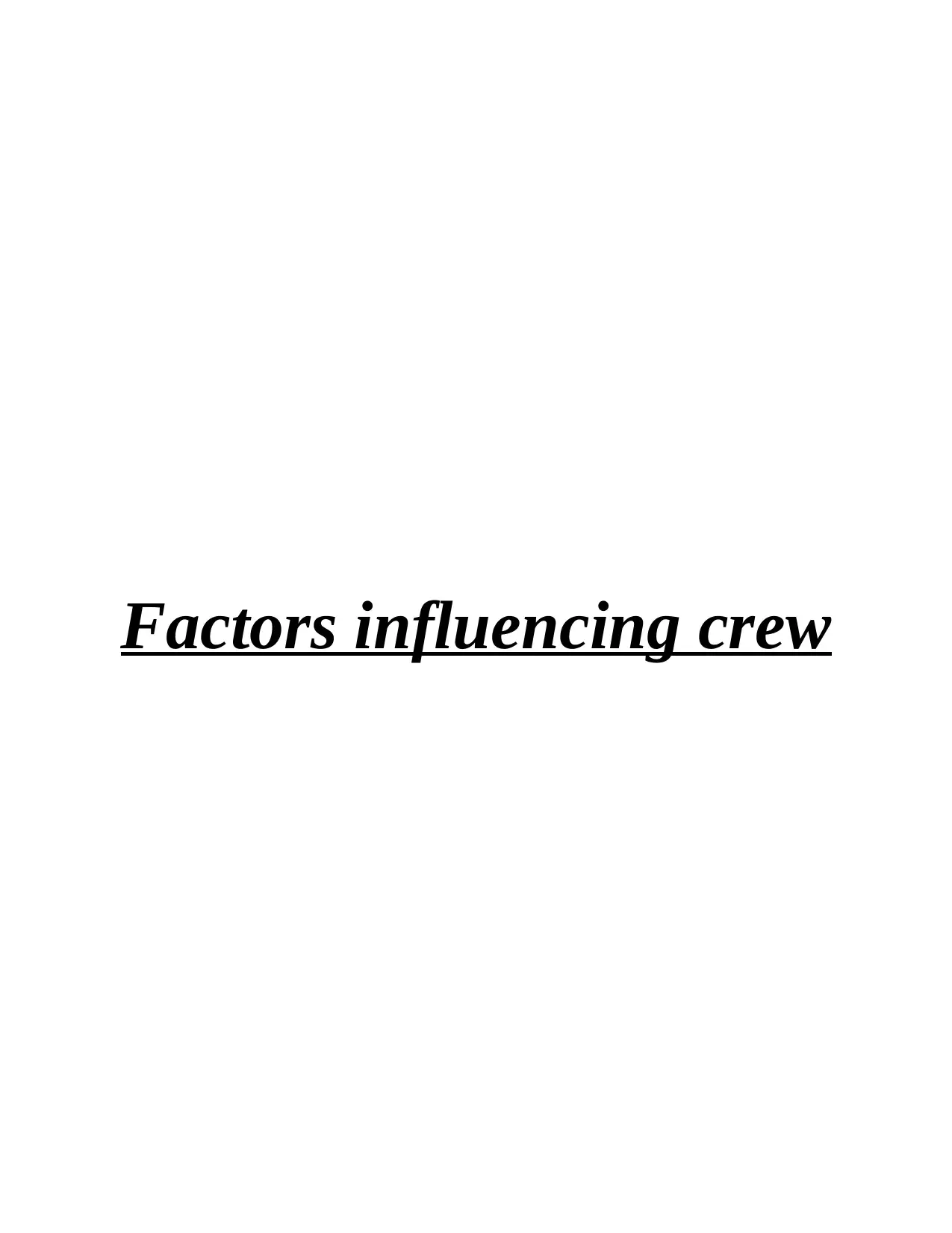
Factors influencing crew
Paraphrase This Document
Need a fresh take? Get an instant paraphrase of this document with our AI Paraphraser

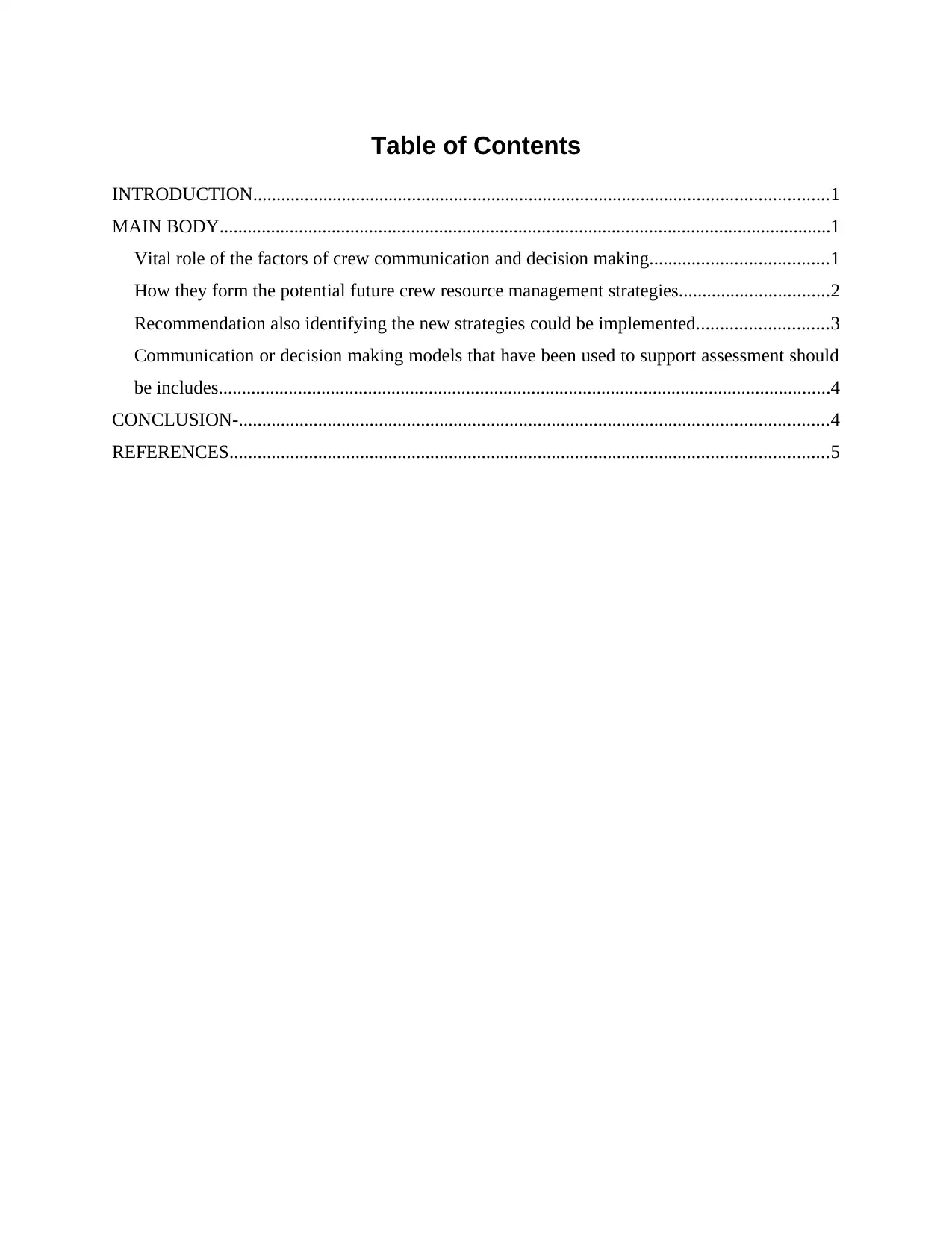
Table of Contents
INTRODUCTION...........................................................................................................................1
MAIN BODY...................................................................................................................................1
Vital role of the factors of crew communication and decision making......................................1
How they form the potential future crew resource management strategies................................2
Recommendation also identifying the new strategies could be implemented............................3
Communication or decision making models that have been used to support assessment should
be includes...................................................................................................................................4
CONCLUSION-..............................................................................................................................4
REFERENCES................................................................................................................................5
INTRODUCTION...........................................................................................................................1
MAIN BODY...................................................................................................................................1
Vital role of the factors of crew communication and decision making......................................1
How they form the potential future crew resource management strategies................................2
Recommendation also identifying the new strategies could be implemented............................3
Communication or decision making models that have been used to support assessment should
be includes...................................................................................................................................4
CONCLUSION-..............................................................................................................................4
REFERENCES................................................................................................................................5
⊘ This is a preview!⊘
Do you want full access?
Subscribe today to unlock all pages.

Trusted by 1+ million students worldwide
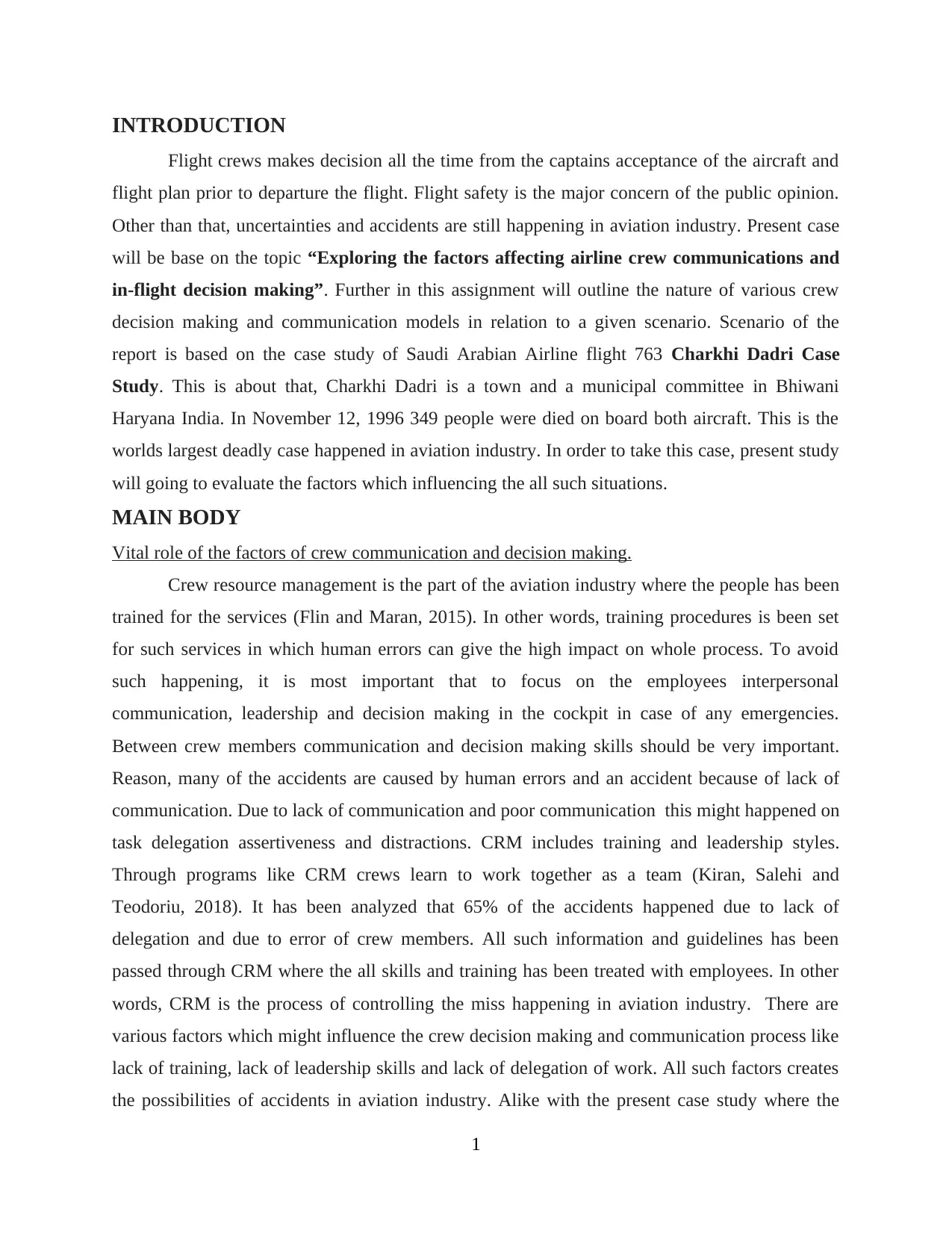
INTRODUCTION
Flight crews makes decision all the time from the captains acceptance of the aircraft and
flight plan prior to departure the flight. Flight safety is the major concern of the public opinion.
Other than that, uncertainties and accidents are still happening in aviation industry. Present case
will be base on the topic “Exploring the factors affecting airline crew communications and
in-flight decision making”. Further in this assignment will outline the nature of various crew
decision making and communication models in relation to a given scenario. Scenario of the
report is based on the case study of Saudi Arabian Airline flight 763 Charkhi Dadri Case
Study. This is about that, Charkhi Dadri is a town and a municipal committee in Bhiwani
Haryana India. In November 12, 1996 349 people were died on board both aircraft. This is the
worlds largest deadly case happened in aviation industry. In order to take this case, present study
will going to evaluate the factors which influencing the all such situations.
MAIN BODY
Vital role of the factors of crew communication and decision making.
Crew resource management is the part of the aviation industry where the people has been
trained for the services (Flin and Maran, 2015). In other words, training procedures is been set
for such services in which human errors can give the high impact on whole process. To avoid
such happening, it is most important that to focus on the employees interpersonal
communication, leadership and decision making in the cockpit in case of any emergencies.
Between crew members communication and decision making skills should be very important.
Reason, many of the accidents are caused by human errors and an accident because of lack of
communication. Due to lack of communication and poor communication this might happened on
task delegation assertiveness and distractions. CRM includes training and leadership styles.
Through programs like CRM crews learn to work together as a team (Kiran, Salehi and
Teodoriu, 2018). It has been analyzed that 65% of the accidents happened due to lack of
delegation and due to error of crew members. All such information and guidelines has been
passed through CRM where the all skills and training has been treated with employees. In other
words, CRM is the process of controlling the miss happening in aviation industry. There are
various factors which might influence the crew decision making and communication process like
lack of training, lack of leadership skills and lack of delegation of work. All such factors creates
the possibilities of accidents in aviation industry. Alike with the present case study where the
1
Flight crews makes decision all the time from the captains acceptance of the aircraft and
flight plan prior to departure the flight. Flight safety is the major concern of the public opinion.
Other than that, uncertainties and accidents are still happening in aviation industry. Present case
will be base on the topic “Exploring the factors affecting airline crew communications and
in-flight decision making”. Further in this assignment will outline the nature of various crew
decision making and communication models in relation to a given scenario. Scenario of the
report is based on the case study of Saudi Arabian Airline flight 763 Charkhi Dadri Case
Study. This is about that, Charkhi Dadri is a town and a municipal committee in Bhiwani
Haryana India. In November 12, 1996 349 people were died on board both aircraft. This is the
worlds largest deadly case happened in aviation industry. In order to take this case, present study
will going to evaluate the factors which influencing the all such situations.
MAIN BODY
Vital role of the factors of crew communication and decision making.
Crew resource management is the part of the aviation industry where the people has been
trained for the services (Flin and Maran, 2015). In other words, training procedures is been set
for such services in which human errors can give the high impact on whole process. To avoid
such happening, it is most important that to focus on the employees interpersonal
communication, leadership and decision making in the cockpit in case of any emergencies.
Between crew members communication and decision making skills should be very important.
Reason, many of the accidents are caused by human errors and an accident because of lack of
communication. Due to lack of communication and poor communication this might happened on
task delegation assertiveness and distractions. CRM includes training and leadership styles.
Through programs like CRM crews learn to work together as a team (Kiran, Salehi and
Teodoriu, 2018). It has been analyzed that 65% of the accidents happened due to lack of
delegation and due to error of crew members. All such information and guidelines has been
passed through CRM where the all skills and training has been treated with employees. In other
words, CRM is the process of controlling the miss happening in aviation industry. There are
various factors which might influence the crew decision making and communication process like
lack of training, lack of leadership skills and lack of delegation of work. All such factors creates
the possibilities of accidents in aviation industry. Alike with the present case study where the
1
Paraphrase This Document
Need a fresh take? Get an instant paraphrase of this document with our AI Paraphraser
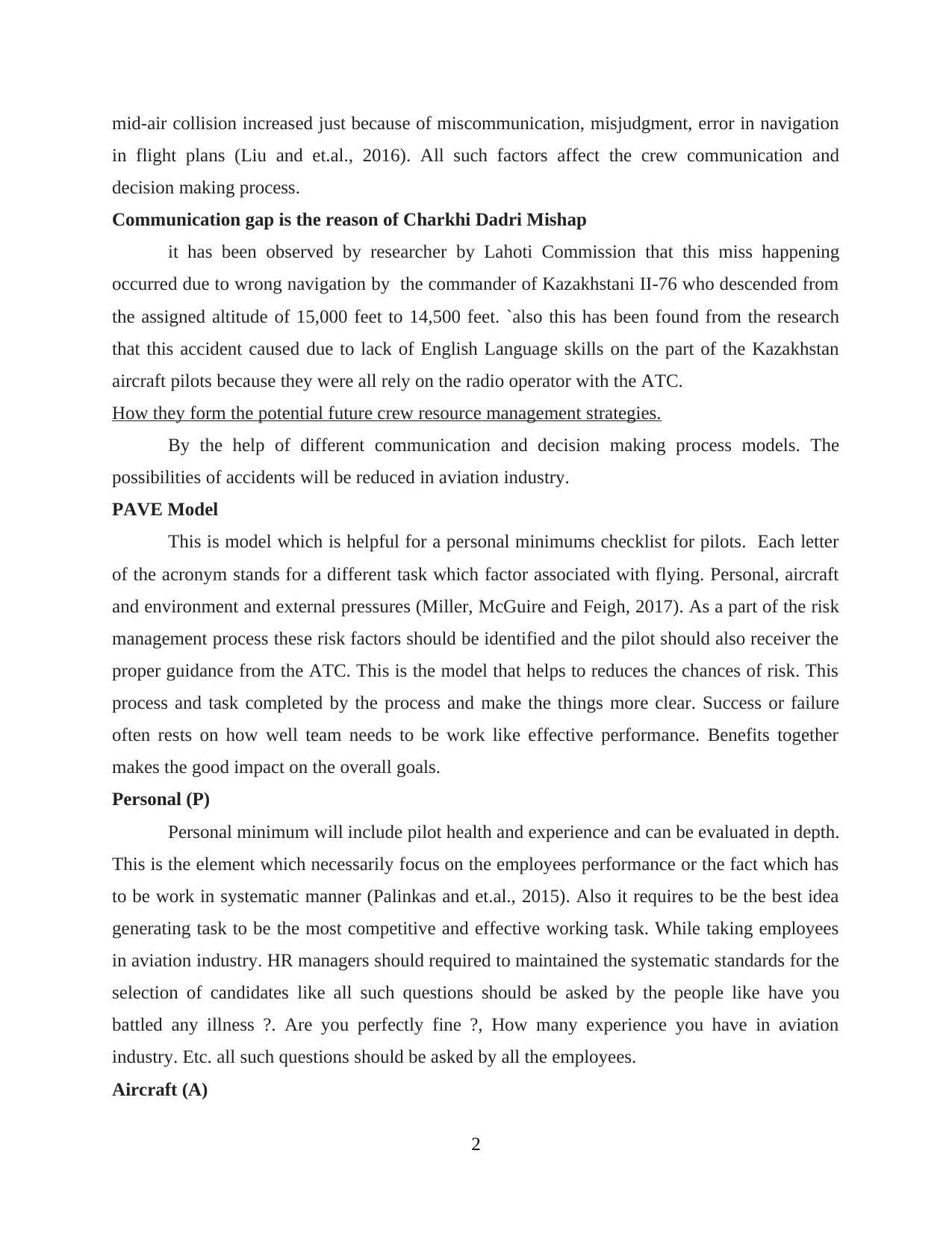
mid-air collision increased just because of miscommunication, misjudgment, error in navigation
in flight plans (Liu and et.al., 2016). All such factors affect the crew communication and
decision making process.
Communication gap is the reason of Charkhi Dadri Mishap
it has been observed by researcher by Lahoti Commission that this miss happening
occurred due to wrong navigation by the commander of Kazakhstani II-76 who descended from
the assigned altitude of 15,000 feet to 14,500 feet. `also this has been found from the research
that this accident caused due to lack of English Language skills on the part of the Kazakhstan
aircraft pilots because they were all rely on the radio operator with the ATC.
How they form the potential future crew resource management strategies.
By the help of different communication and decision making process models. The
possibilities of accidents will be reduced in aviation industry.
PAVE Model
This is model which is helpful for a personal minimums checklist for pilots. Each letter
of the acronym stands for a different task which factor associated with flying. Personal, aircraft
and environment and external pressures (Miller, McGuire and Feigh, 2017). As a part of the risk
management process these risk factors should be identified and the pilot should also receiver the
proper guidance from the ATC. This is the model that helps to reduces the chances of risk. This
process and task completed by the process and make the things more clear. Success or failure
often rests on how well team needs to be work like effective performance. Benefits together
makes the good impact on the overall goals.
Personal (P)
Personal minimum will include pilot health and experience and can be evaluated in depth.
This is the element which necessarily focus on the employees performance or the fact which has
to be work in systematic manner (Palinkas and et.al., 2015). Also it requires to be the best idea
generating task to be the most competitive and effective working task. While taking employees
in aviation industry. HR managers should required to maintained the systematic standards for the
selection of candidates like all such questions should be asked by the people like have you
battled any illness ?. Are you perfectly fine ?, How many experience you have in aviation
industry. Etc. all such questions should be asked by all the employees.
Aircraft (A)
2
in flight plans (Liu and et.al., 2016). All such factors affect the crew communication and
decision making process.
Communication gap is the reason of Charkhi Dadri Mishap
it has been observed by researcher by Lahoti Commission that this miss happening
occurred due to wrong navigation by the commander of Kazakhstani II-76 who descended from
the assigned altitude of 15,000 feet to 14,500 feet. `also this has been found from the research
that this accident caused due to lack of English Language skills on the part of the Kazakhstan
aircraft pilots because they were all rely on the radio operator with the ATC.
How they form the potential future crew resource management strategies.
By the help of different communication and decision making process models. The
possibilities of accidents will be reduced in aviation industry.
PAVE Model
This is model which is helpful for a personal minimums checklist for pilots. Each letter
of the acronym stands for a different task which factor associated with flying. Personal, aircraft
and environment and external pressures (Miller, McGuire and Feigh, 2017). As a part of the risk
management process these risk factors should be identified and the pilot should also receiver the
proper guidance from the ATC. This is the model that helps to reduces the chances of risk. This
process and task completed by the process and make the things more clear. Success or failure
often rests on how well team needs to be work like effective performance. Benefits together
makes the good impact on the overall goals.
Personal (P)
Personal minimum will include pilot health and experience and can be evaluated in depth.
This is the element which necessarily focus on the employees performance or the fact which has
to be work in systematic manner (Palinkas and et.al., 2015). Also it requires to be the best idea
generating task to be the most competitive and effective working task. While taking employees
in aviation industry. HR managers should required to maintained the systematic standards for the
selection of candidates like all such questions should be asked by the people like have you
battled any illness ?. Are you perfectly fine ?, How many experience you have in aviation
industry. Etc. all such questions should be asked by all the employees.
Aircraft (A)
2

This is the another checklist points which must be checked by the pilot. Did it undergo
any inspections recently which did it happened fuel necessary. Aircraft checklist is the most
essential checklist for the aviation industry which has to be done in a proper way that also helps
to reduced the chances of aircraft failures (Powell and et.al., 2015). Are you comfortable with the
weight and balance and performance for the flight. Also it requires the best services and make
the fast growing efforts in the process of making the things more effective. Also it helps to make
the things more complicated and influencing.
Environment (E)
this is the another element which must be checked by the aviation support team and the
pilot of the flight too. It is the responsibility of the team members to measure the temperature of
weather and ensure that yes in particular weather flight will be safely reached to the destination.
External Pressures (E)
This checklist assure the plan B if in case the situation is uncontrollable. This checklist
must be assured some of the questions like does Pilot have plan B, Does pilot is confident ?.
Recommendation also identifying the new strategies could be implemented.
There are some new innovation is required in within the aviation industry after seeing the
case of Charkhi Dadri Mid Collision on November 12, 1996 due to miscommunication and
wrong decision taken by pilots (Roche, 2016). There are some new changes required in the
future with crew management and flight operation. This following item will effectively deal with
the new challenges and get overcome from the issues faced by the Collision.
It has been recommend to the application that capable of increasing efficiency in crew
management as well as dealing with the additional need of increasing customer understanding.
The aviation industry should be focus on the crew management which is is the most essential
part in the management. Crew management involves management which presented in the flight.
For all those people communication skill must be very important and necessary. In case of any
miscommunication this such kind of things are very improper (Tolin and et.al., 2015). Aviation
industry should also need to get high advanced services from the information technology which
happened in the system. Effective technologies and way of communication can helpful way to
communicate with the large formation growth.
There must be a proper training system with crew management with situational crisis
communication theory is one tool that can be used during the recovery phase. This situation can
3
any inspections recently which did it happened fuel necessary. Aircraft checklist is the most
essential checklist for the aviation industry which has to be done in a proper way that also helps
to reduced the chances of aircraft failures (Powell and et.al., 2015). Are you comfortable with the
weight and balance and performance for the flight. Also it requires the best services and make
the fast growing efforts in the process of making the things more effective. Also it helps to make
the things more complicated and influencing.
Environment (E)
this is the another element which must be checked by the aviation support team and the
pilot of the flight too. It is the responsibility of the team members to measure the temperature of
weather and ensure that yes in particular weather flight will be safely reached to the destination.
External Pressures (E)
This checklist assure the plan B if in case the situation is uncontrollable. This checklist
must be assured some of the questions like does Pilot have plan B, Does pilot is confident ?.
Recommendation also identifying the new strategies could be implemented.
There are some new innovation is required in within the aviation industry after seeing the
case of Charkhi Dadri Mid Collision on November 12, 1996 due to miscommunication and
wrong decision taken by pilots (Roche, 2016). There are some new changes required in the
future with crew management and flight operation. This following item will effectively deal with
the new challenges and get overcome from the issues faced by the Collision.
It has been recommend to the application that capable of increasing efficiency in crew
management as well as dealing with the additional need of increasing customer understanding.
The aviation industry should be focus on the crew management which is is the most essential
part in the management. Crew management involves management which presented in the flight.
For all those people communication skill must be very important and necessary. In case of any
miscommunication this such kind of things are very improper (Tolin and et.al., 2015). Aviation
industry should also need to get high advanced services from the information technology which
happened in the system. Effective technologies and way of communication can helpful way to
communicate with the large formation growth.
There must be a proper training system with crew management with situational crisis
communication theory is one tool that can be used during the recovery phase. This situation can
3
⊘ This is a preview!⊘
Do you want full access?
Subscribe today to unlock all pages.

Trusted by 1+ million students worldwide
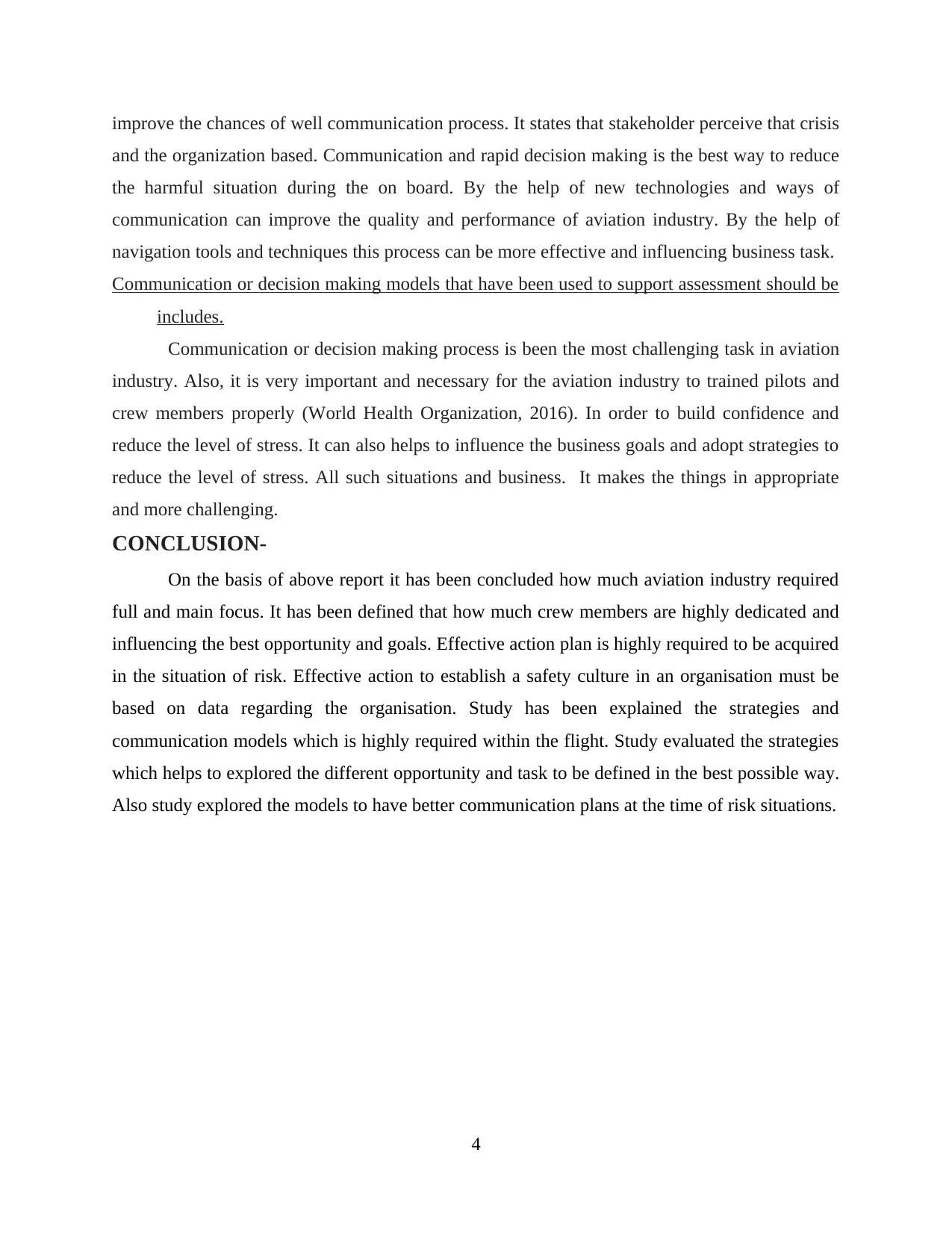
improve the chances of well communication process. It states that stakeholder perceive that crisis
and the organization based. Communication and rapid decision making is the best way to reduce
the harmful situation during the on board. By the help of new technologies and ways of
communication can improve the quality and performance of aviation industry. By the help of
navigation tools and techniques this process can be more effective and influencing business task.
Communication or decision making models that have been used to support assessment should be
includes.
Communication or decision making process is been the most challenging task in aviation
industry. Also, it is very important and necessary for the aviation industry to trained pilots and
crew members properly (World Health Organization, 2016). In order to build confidence and
reduce the level of stress. It can also helps to influence the business goals and adopt strategies to
reduce the level of stress. All such situations and business. It makes the things in appropriate
and more challenging.
CONCLUSION-
On the basis of above report it has been concluded how much aviation industry required
full and main focus. It has been defined that how much crew members are highly dedicated and
influencing the best opportunity and goals. Effective action plan is highly required to be acquired
in the situation of risk. Effective action to establish a safety culture in an organisation must be
based on data regarding the organisation. Study has been explained the strategies and
communication models which is highly required within the flight. Study evaluated the strategies
which helps to explored the different opportunity and task to be defined in the best possible way.
Also study explored the models to have better communication plans at the time of risk situations.
4
and the organization based. Communication and rapid decision making is the best way to reduce
the harmful situation during the on board. By the help of new technologies and ways of
communication can improve the quality and performance of aviation industry. By the help of
navigation tools and techniques this process can be more effective and influencing business task.
Communication or decision making models that have been used to support assessment should be
includes.
Communication or decision making process is been the most challenging task in aviation
industry. Also, it is very important and necessary for the aviation industry to trained pilots and
crew members properly (World Health Organization, 2016). In order to build confidence and
reduce the level of stress. It can also helps to influence the business goals and adopt strategies to
reduce the level of stress. All such situations and business. It makes the things in appropriate
and more challenging.
CONCLUSION-
On the basis of above report it has been concluded how much aviation industry required
full and main focus. It has been defined that how much crew members are highly dedicated and
influencing the best opportunity and goals. Effective action plan is highly required to be acquired
in the situation of risk. Effective action to establish a safety culture in an organisation must be
based on data regarding the organisation. Study has been explained the strategies and
communication models which is highly required within the flight. Study evaluated the strategies
which helps to explored the different opportunity and task to be defined in the best possible way.
Also study explored the models to have better communication plans at the time of risk situations.
4
Paraphrase This Document
Need a fresh take? Get an instant paraphrase of this document with our AI Paraphraser
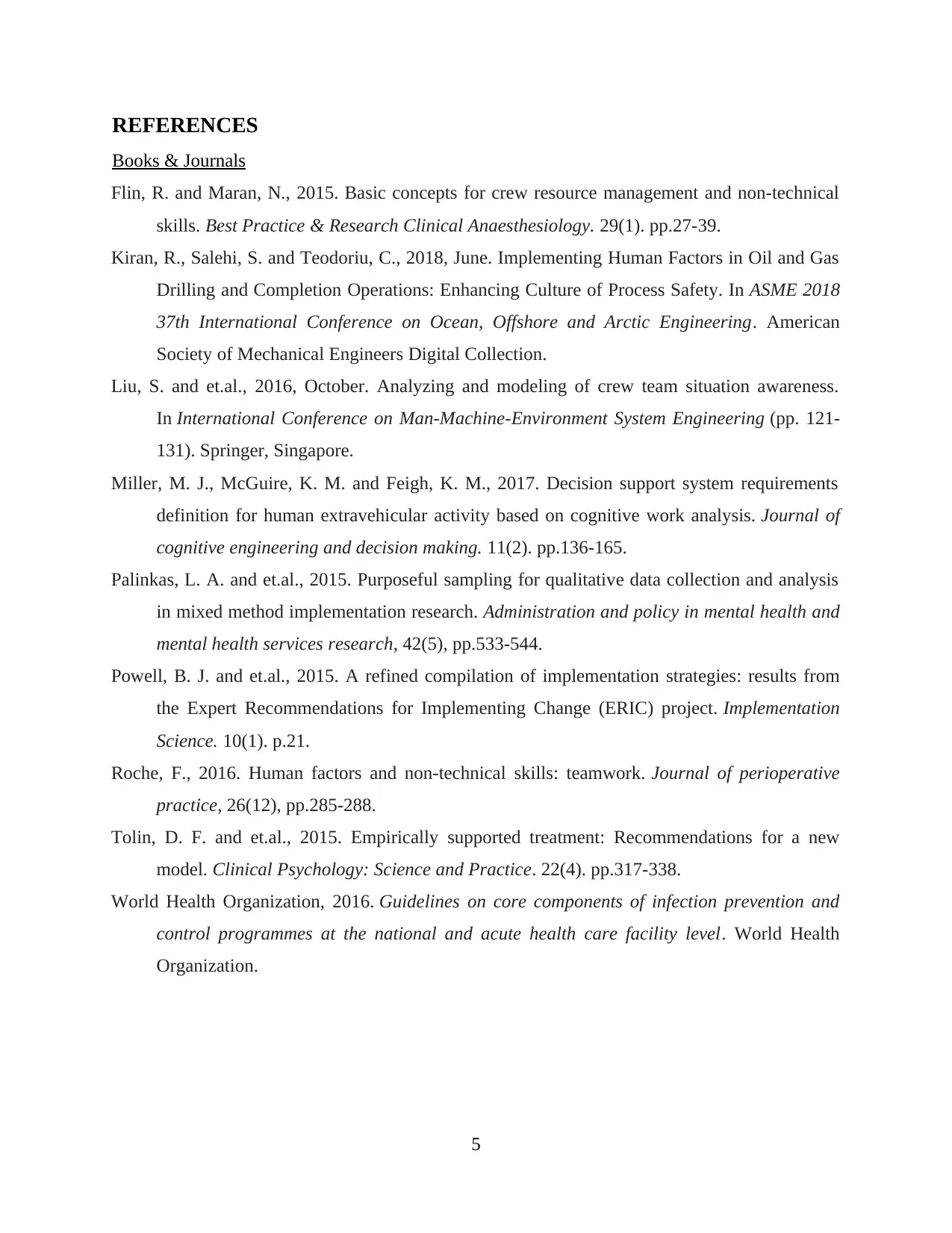
REFERENCES
Books & Journals
Flin, R. and Maran, N., 2015. Basic concepts for crew resource management and non-technical
skills. Best Practice & Research Clinical Anaesthesiology. 29(1). pp.27-39.
Kiran, R., Salehi, S. and Teodoriu, C., 2018, June. Implementing Human Factors in Oil and Gas
Drilling and Completion Operations: Enhancing Culture of Process Safety. In ASME 2018
37th International Conference on Ocean, Offshore and Arctic Engineering. American
Society of Mechanical Engineers Digital Collection.
Liu, S. and et.al., 2016, October. Analyzing and modeling of crew team situation awareness.
In International Conference on Man-Machine-Environment System Engineering (pp. 121-
131). Springer, Singapore.
Miller, M. J., McGuire, K. M. and Feigh, K. M., 2017. Decision support system requirements
definition for human extravehicular activity based on cognitive work analysis. Journal of
cognitive engineering and decision making. 11(2). pp.136-165.
Palinkas, L. A. and et.al., 2015. Purposeful sampling for qualitative data collection and analysis
in mixed method implementation research. Administration and policy in mental health and
mental health services research, 42(5), pp.533-544.
Powell, B. J. and et.al., 2015. A refined compilation of implementation strategies: results from
the Expert Recommendations for Implementing Change (ERIC) project. Implementation
Science. 10(1). p.21.
Roche, F., 2016. Human factors and non-technical skills: teamwork. Journal of perioperative
practice, 26(12), pp.285-288.
Tolin, D. F. and et.al., 2015. Empirically supported treatment: Recommendations for a new
model. Clinical Psychology: Science and Practice. 22(4). pp.317-338.
World Health Organization, 2016. Guidelines on core components of infection prevention and
control programmes at the national and acute health care facility level. World Health
Organization.
5
Books & Journals
Flin, R. and Maran, N., 2015. Basic concepts for crew resource management and non-technical
skills. Best Practice & Research Clinical Anaesthesiology. 29(1). pp.27-39.
Kiran, R., Salehi, S. and Teodoriu, C., 2018, June. Implementing Human Factors in Oil and Gas
Drilling and Completion Operations: Enhancing Culture of Process Safety. In ASME 2018
37th International Conference on Ocean, Offshore and Arctic Engineering. American
Society of Mechanical Engineers Digital Collection.
Liu, S. and et.al., 2016, October. Analyzing and modeling of crew team situation awareness.
In International Conference on Man-Machine-Environment System Engineering (pp. 121-
131). Springer, Singapore.
Miller, M. J., McGuire, K. M. and Feigh, K. M., 2017. Decision support system requirements
definition for human extravehicular activity based on cognitive work analysis. Journal of
cognitive engineering and decision making. 11(2). pp.136-165.
Palinkas, L. A. and et.al., 2015. Purposeful sampling for qualitative data collection and analysis
in mixed method implementation research. Administration and policy in mental health and
mental health services research, 42(5), pp.533-544.
Powell, B. J. and et.al., 2015. A refined compilation of implementation strategies: results from
the Expert Recommendations for Implementing Change (ERIC) project. Implementation
Science. 10(1). p.21.
Roche, F., 2016. Human factors and non-technical skills: teamwork. Journal of perioperative
practice, 26(12), pp.285-288.
Tolin, D. F. and et.al., 2015. Empirically supported treatment: Recommendations for a new
model. Clinical Psychology: Science and Practice. 22(4). pp.317-338.
World Health Organization, 2016. Guidelines on core components of infection prevention and
control programmes at the national and acute health care facility level. World Health
Organization.
5
1 out of 8
Related Documents
Your All-in-One AI-Powered Toolkit for Academic Success.
+13062052269
info@desklib.com
Available 24*7 on WhatsApp / Email
![[object Object]](/_next/static/media/star-bottom.7253800d.svg)
Unlock your academic potential
Copyright © 2020–2025 A2Z Services. All Rights Reserved. Developed and managed by ZUCOL.



